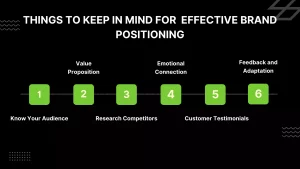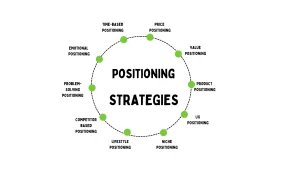Brand Positioning: Complete Guide for 2024
Nike, a prime example of effective brand positioning, has solidified its identity as a symbol of inspiration, athleticism, and empowerment.
With its iconic “Just Do It” slogan and memorable swoosh logo, Nike resonates with consumers on both emotional and functional levels.

Through its strategic alignment with athletes and its commitment to innovation, Nike has positioned itself as a leading sports and lifestyle brand, capturing the hearts of individuals seeking to push their boundaries and embrace an active lifestyle.
Consumers who harp on workout and lifestyles, think about Nike.
If this excites you, read more about brand positioning.
Define Positioning Marketing
Positioning in marketing refers to the strategic process of establishing a distinct and favourable perception of a product, brand, or company within the minds of target consumers.

It involves creating a unique identity and value proposition that sets the offering apart from competitors and resonates with the intended audience.
Effective positioning shapes how consumers perceive the product’s benefits, features, and relevance, ultimately influencing their purchasing decisions. Successful positioning addresses consumer needs, highlights competitive advantages, and aims to occupy a specific place in the market that aligns with the target audience’s preferences and aspirations.
For effective brand positioning, you may keep this in mind:

- Know Your Audience: Understand your target audience’s needs, preferences, and pain points. Tailor your positioning to address their specific desires and challenges.
- Differentiation: Identify what sets your product or brand apart from competitors. Highlight unique features, benefits, or qualities that make you stand out.
- Value Proposition: Clearly communicate the value your offering provides. Explain how it solves problems or enhances the lives of your customers.
- Consistency: Maintain consistency across all touchpoints – from messaging to visual identity. Consistency reinforces your positioning and builds brand recognition.
- Research Competitors: Analyse your competitors’ positioning strategies. Identify gaps or areas where you can offer a distinct advantage.
- Relevance: Ensure your positioning is relevant to the current market trends and consumer preferences. Stay updated and adapt your positioning as needed.
- Emotional Connection: Develop an emotional connection with your audience. Positioning that evokes emotions can create a strong bond with customers.
- Targeted Messaging: Craft messaging that resonates with your audience’s aspirations, values, and language. Speak directly to their needs.
- Simplicity: Keep your positioning message simple and easy to understand. Avoid jargon or complex language that might confuse your audience.
- Visual Identity: Visual elements like logos, colours, and design contribute to your positioning. Make sure they align with the perception you want to create.
- Customer Testimonials: Use customer testimonials or success stories to validate your positioning. Real-life examples can reinforce your claims.
- Continuous Monitoring: Regularly assess how your positioning is resonating with your audience. Adapt and refine as market dynamics change.
- Stay True to Your Promise: Deliver on the promises made through your positioning. Consistency between your messaging and actual customer experience builds trust.
- Long-term Strategy: Positioning isn’t a one-time task. It’s a long-term strategy that needs to evolve alongside changes in the market and your brand’s growth.
- Feedback and Adaptation: Listen to customer feedback and be open to adapting your positioning if necessary. A willingness to improve demonstrates customer-centricity.
Different Positioning Strategies
These are the different positioning strategies.
Positioning strategies are critical for businesses to create a distinct image and perception of their products or services in the minds of their target customers. These strategies help differentiate a brand from its competitors and influence how consumers perceive and value what the brand offers. Here are some major positioning strategies:

- Price Positioning:
- Low-Cost Provider: This strategy focuses on offering products or services at the lowest possible price. It appeals to price-sensitive customers looking for budget-friendly options. Examples include Walmart and Ryanair.
- Premium Pricing: This strategy positions a product or service as high-quality and premium, often charging a higher price to reflect exclusivity and superior features. Luxury brands like Rolex and Ferrari use this strategy.
- Quality or Value Positioning:
- High-Quality: Emphasising superior quality and performance to justify a higher price. Brands like Apple and Mercedes-Benz are known for their high-quality positioning.
- Best Value: Offering a balance between quality and price to provide the best overall value. Brands like Toyota and Costco have adopted this strategy.
- Product Features and Innovation Positioning:
- Innovation Leader: Positioning as a pioneer in technology and innovation, often associated with cutting-edge products. Apple and Tesla are examples.
- Feature-Centric: Emphasising specific product features or attributes as a unique selling point. GoPro, for instance, focuses on its action cameras’ durability and versatility.
- User Experience and Convenience Positioning:
- Convenience Leader: Positioning as the most convenient option for customers. Amazon and Uber excel in providing convenience.
- User Experience-Centric: Prioritising user-friendly interfaces and excellent customer service. Brands like Airbnb and Airbnb prioritise the customer experience.
- Niche Positioning:
- Specialisation: Targeting a specific niche market or segment with unique needs. Examples include Whole Foods (organic and natural foods) and Dollar Shave Club (affordable razors).
- Geographic: Focusing on a particular geographic region or market. In-N-Out Burger primarily serves the West Coast of the United States.
- Brand Image and Lifestyle Positioning:
- Lifestyle Brand: Aligning the brand with a particular lifestyle or set of values. Patagonia, for example, emphasises environmental sustainability and outdoor adventure.
- Brand Personality: Creating a distinct brand personality that resonates with the target audience. Coca-Cola has a brand personality associated with happiness and togetherness.
- Competitor-Based Positioning:
- Differentiation from Competitors: Highlighting what sets your brand apart from competitors. Avis famously positioned itself as “We Try Harder” to differentiate from Hertz.
- Comparison with Competitors: Directly comparing your product or service to competitors to show superiority. An example is Verizon vs. AT&T’s “Can You Hear Me Now?” campaign.
- Problem-Solving Positioning:
- Problem Solver: Position your product as the solution to a specific problem or pain point. TurboTax is an example offering solutions for tax-related challenges.
- Emotional Positioning:
- Emotional Connection: Building an emotional connection with customers by evoking specific emotions through marketing and branding. Dove’s “Real Beauty” campaign focuses on self-esteem and body positivity.
- Time-Based Positioning:
- Urgency or Scarcity: Creating a sense of urgency or scarcity to drive immediate action. Phrases like “limited time offer” or “while supplies last” are standard in this strategy.
Steps to Create Brand Positioning: Guide in 2023
Creating a brand positioning strategy involves several strategic steps to define your brand’s unique value and resonate with your target audience. Here’s a step-by-step guide:

1. Market Research:
Conduct thorough research to understand your industry, competitors, and target audience. Identify market trends, consumer preferences, and gaps in the market that your brand can fill.
- Clarify the objectives and outcomes you intend to achieve through the research.
- Identify and understand your ideal customer’s demographics, behaviours, and preferences.
- Study competitors’ positioning strategies, differentiators, and messaging.
- Investigate the pain points, desires, and expectations of your target audience.
- Determine what makes your brand stand out and its unique value proposition (UVP).
- Gather feedback from your audience to gauge how they currently perceive your brand.
- Collect insights from current customers regarding their experiences and perceptions.
- Explore industry trends that influence your brand’s positioning.
- Evaluate your brand’s strengths, weaknesses, opportunities, and threats concerning positioning.
- Use gathered insights to refine your brand’s positioning strategy for optimal resonance.
2. Define Target Audience:
Define your ideal customers based on demographics, behaviours, and psychographics. Understand their needs, pain points, and aspirations to tailor your positioning strategy.
- Identify key demographic factors such as age, gender, income, education, and location.
- Understand their lifestyle, values, interests, behaviours, and motivations.
- Determine the specific problems they want to solve and their challenges.
- Gain insights into their goals, desires, and what they aspire to achieve in relation to your product or service.
3. Identify Unique Value Proposition (UVP):
Determine what separates your brand. Define your Unique Value Proposition – the unique benefits or solutions your brand offers that competitors don’t. This becomes the core of your positioning.
- Integrate your UVP into your brand’s messaging to succinctly communicate what sets your brand apart.
- Emphasise your UVP to highlight how your brand is distinct from competitors.
- Showcase the specific benefits and solutions your UVP offers to address your target audience’s needs.
- Ensure your UVP is consistently reflected in all aspects of your brand, from marketing materials to customer interactions.
4. Develop Key Messages:
Craft key messages highlighting your UVP and resonating with your target audience. These messages should communicate how your brand addresses customer needs and why it’s the best choice.
5. Positioning Statement:
Create a concise and impactful positioning statement that encapsulates your brand’s essence, target audience, UVP, and benefits. This statement should guide all branding efforts.
- Stay focused on the core message.
- Clearly convey what sets your brand apart.
- Identify the specific audience you’re targeting.
- Highlight the benefits your audience will gain.
- Ensure alignment with your brand’s values and messaging.
6. Analyse Competitors:
Study competitors’ positioning strategies to identify gaps and opportunities. Differentiate your brand by highlighting aspects that your competitors don’t emphasise. Why?
- Discover opportunities where your brand can differentiate.
- Understand industry standards and best practices.
- Emphasise aspects that set your brand apart.
- Adapt your positioning to remain competitive.
- Learn from competitors’ successes and failures.
7. Brand Personality and Tone:
Define your brand’s personality and tone. Decide how you want your brand to come across – whether it’s friendly, professional, innovative, or something else – and ensure consistency in all communications.
8. Test and Refine:
Share your positioning with a sample audience and gather feedback. Refine your strategy based on the insights you receive to ensure it effectively resonates with your intended audience.
9. Integrate Across Touchpoints:
Implement your brand positioning consistently across all touchpoints – website, social media, marketing materials, customer service, etc. This ensures a cohesive brand experience. Some more reasons to why you should integrate across touchpoints include:
- It ensures a unified brand experience across all interactions.
- Builds a strong, recognizable brand identity for customers.
- Reiterates your positioning and value at every touchpoint.
- Consistent branding fosters trust and reliability in the minds of customers.
- Presents a coherent brand image regardless of the platform.
10. Monitor and Adapt:
Regularly assess the effectiveness of your brand positioning. Monitor market changes, customer feedback, and business performance. If needed, adapt your positioning to stay relevant.
Brand Positioning Examples
Let us discuss a few brand examples to understand brand positioning in detail:
a. Apple Music Vs Spotify
While both Spotify and Apple Music compete in the music streaming industry, they differentiate themselves through their brand positioning strategies. Spotify focuses on music discovery and user-generated content, projecting a vibrant and social brand image.
Apple Music emphasises its seamless integration with the broader ecosystem, offering a comprehensive entertainment experience while leveraging its reputation for quality and innovation.
| Aspect | Spotify | Apple Music |
|---|---|---|
| Positioning | Largest music streaming service | All-in-one music platform |
| Unique Value | Personalised music discovery | Vast library + exclusive content |
| Brand Identity | Youthful, vibrant, music-centric | Polished, high-quality, innovative |
| Messaging | “Discover new music,” “Playlists made for you” | “50 million songs. All ad-free” |
| User Experience | Easy playlist curation, social sharing | Seamless Apple ecosystem integration |
| Partnerships | Artist collaborations, media partnerships | Exclusive artist content, radio shows |
b. Bumble Vs Tinder
| Aspect | Bumble | Tinder |
|---|---|---|
| Positioning | Empowering women, respectful connections | Social discovery, casual dating |
| Unique Value | Women make the first move, focus on respect | Quick matching, wide user base |
| Brand Identity | Empowerment, equality, meaningful connections | Fun, casual, adventurous |
| Messaging | “Make the first move,” “Date, Meet Friends, Network” | “Match, Chat, Date” |
| User Experience | Women initiate conversations, varied relationship options | Swipe-based matching, diverse user base |
| Partnerships | Collaborates with women-centric causes, networking focus | Partnerships with events, brands, influencers |
Also Read : How Much Does a Logo Design Cost in India
Conclusion
Crafting a compelling brand positioning strategy is paramount for standing out amidst competition. By aligning your brand with a distinctive identity, target audience, and unique value proposition, you pave the way for lasting connections.
Remember with authenticity and consistency across messaging, products, and customer experience build trust and loyalty.
As you move ahead on the journey, we’re here to help. Connect with us at hello[at]noboruworld.com to refine your brand’s position and make your mark in the world of business. Your success story awaits!
FAQ
What is brand positioning?
Brand positioning refers to the distinct place a brand occupies in the minds of its target audience. It’s the intentional effort to define and communicate what sets your brand apart from competitors, highlighting its unique value, attributes, and benefits.
Why is brand positioning important?
Brand positioning shapes how consumers perceive your brand. It helps create differentiation, fostering recognition and trust. A well-defined position guides marketing strategies, influencing messaging, product development, and customer interactions.
How do you identify your target audience for positioning?
Identifying your target audience involves understanding demographics, behaviours, preferences, and pain points. Conduct market research to pinpoint your ideal customers and tailor your positioning to resonate with them.
What elements contribute to effective brand positioning?
An effective brand positioning incorporates a Unique Selling Proposition (USP) that showcases what makes your brand unique. It addresses the needs and desires of your target audience, aligns with your brand’s values, and takes into account competitor analysis.
Can brand positioning evolve over time?
Yes, brand positioning can develop due to market shifts, consumer trends, or changes in your business strategy. Regularly assessing your positioning ensures it remains relevant and resonates with your audience.
How does brand positioning affect marketing efforts?
Brand positioning guides all marketing efforts, from crafting compelling messages to choosing appropriate channels. It ensures consistency and clarity in communicating your brand’s identity, making your marketing efforts more effective in reaching and engaging your desired audience.
Also Read – Effective Amazon Positioning: A Complete Guide



